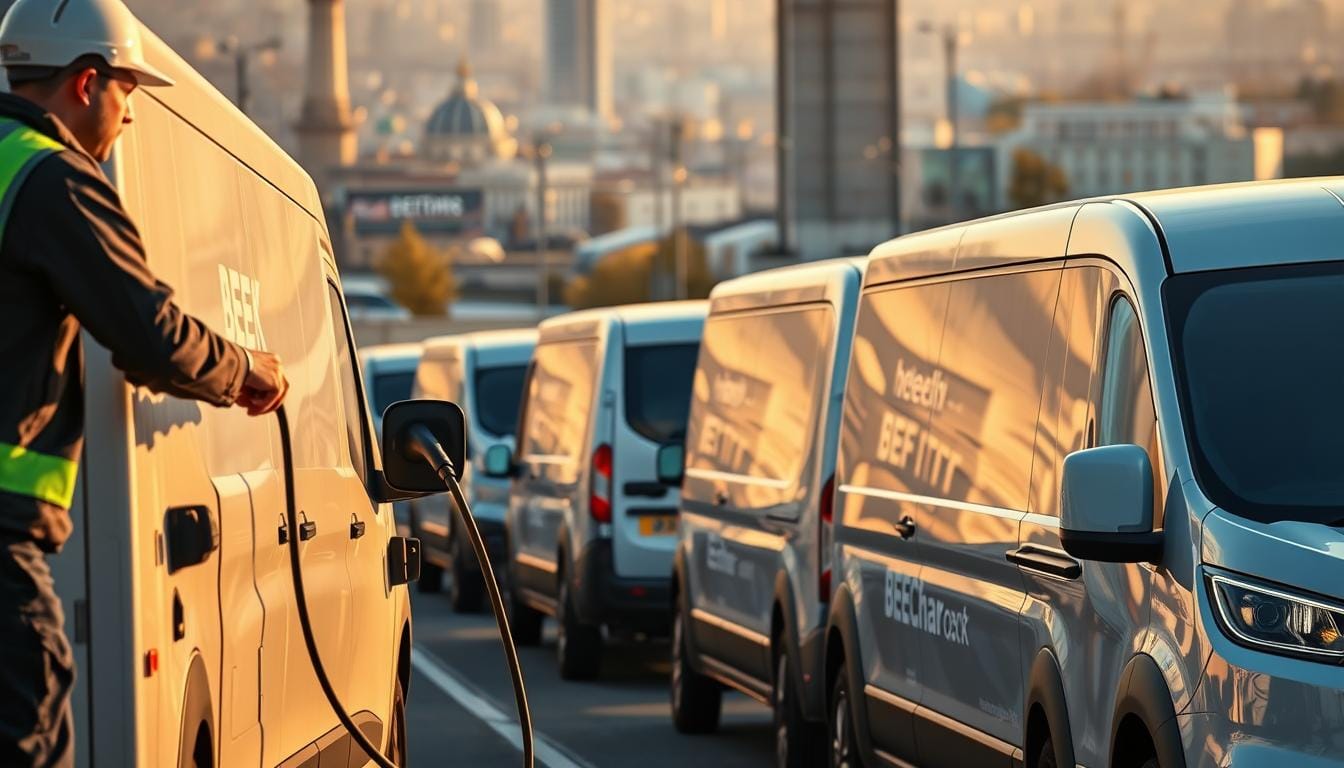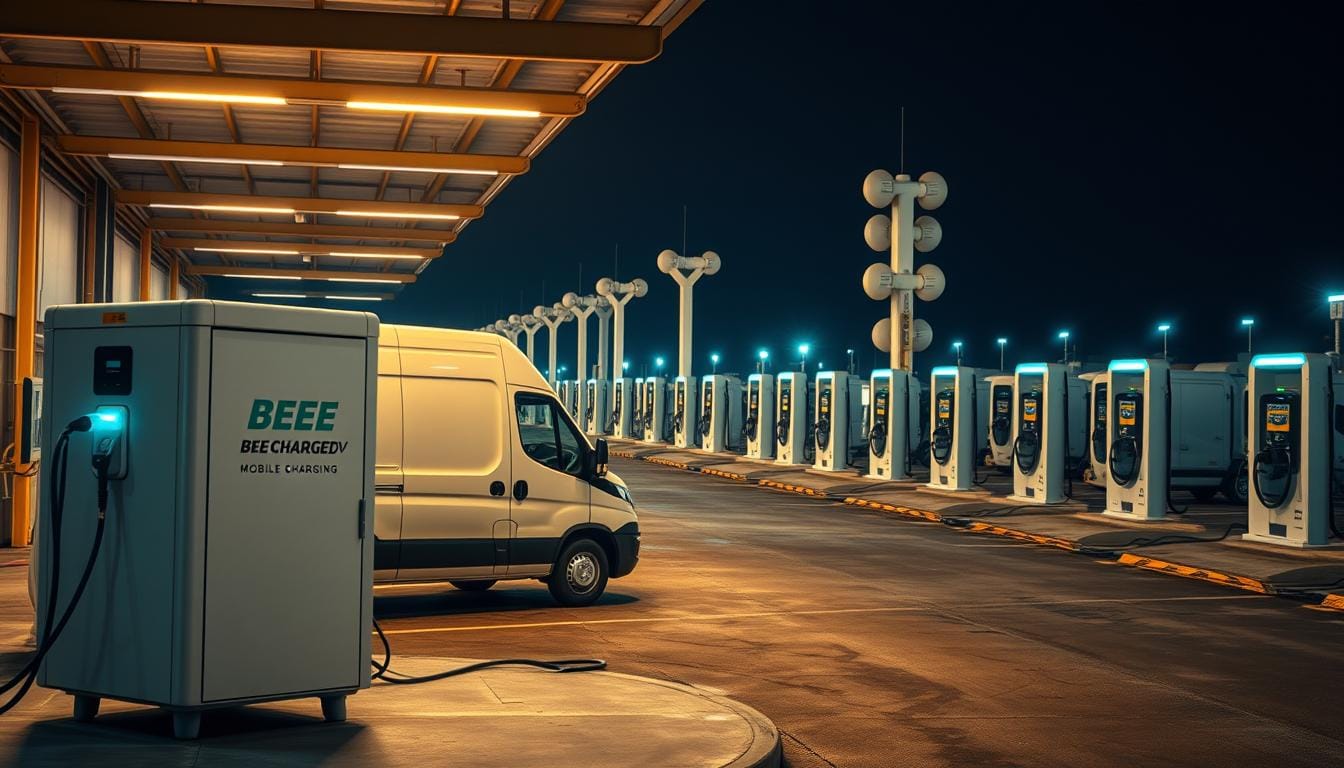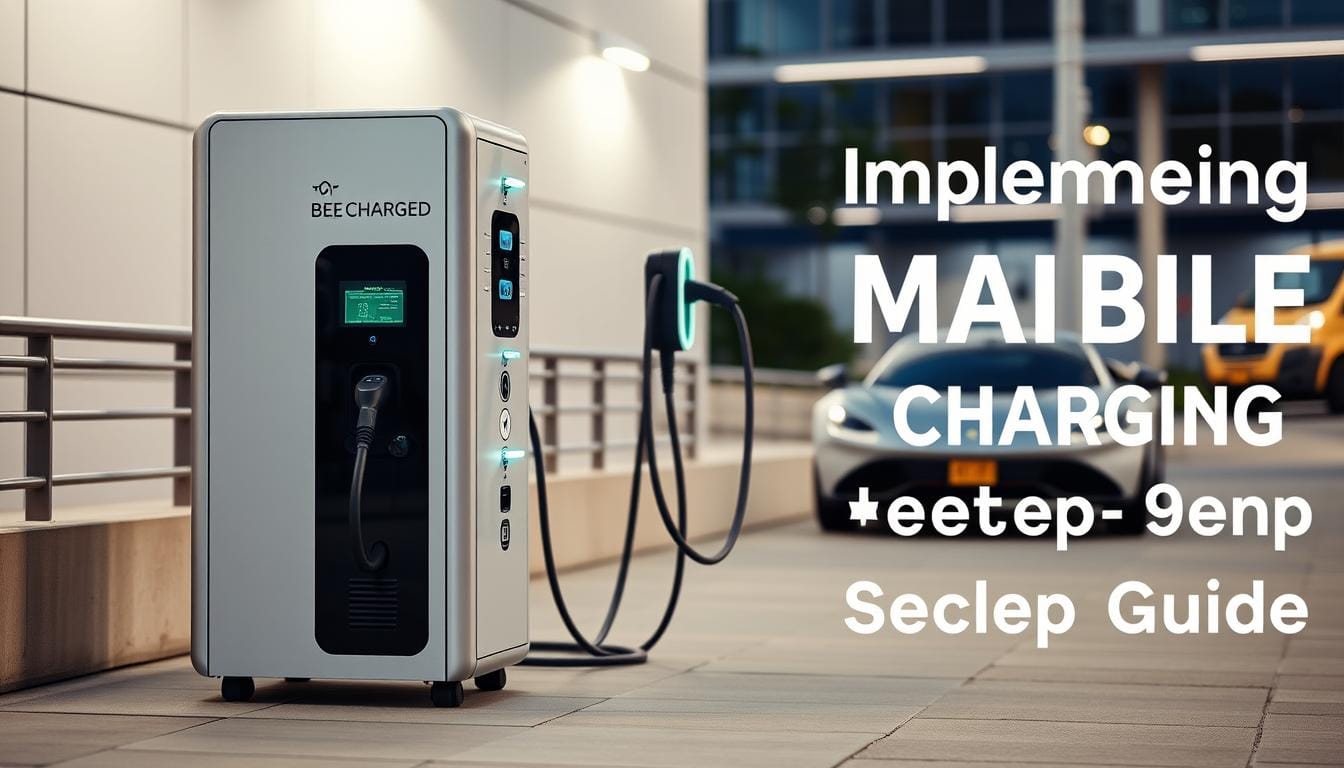In California’s fast-paced logistics industry, maintaining reliable transportation is non-negotiable. Companies face growing pressure to meet deadlines while adopting eco-friendly practices. This is where adaptable energy infrastructure becomes essential for smooth daily operations.

Traditional fixed charging stations often fall short for businesses managing vehicles across large service areas. Remote depots, seasonal demand spikes, and unexpected route changes create challenges. Innovative on-site solutions now offer the flexibility needed to keep vehicles energized without delays.
By deploying portable systems, organizations gain control over their energy supply chain. Real-world applications show companies reducing vehicle idle time by up to 30% while cutting emissions. These advancements directly support California’s sustainability targets without compromising delivery timelines.
Our team specializes in creating customized support for transportation networks. With expertise in energy management and operational efficiency, we help businesses maintain their competitive edge. For immediate assistance, call 888-675-9555 or visit beechargevedev.com to explore tailored solutions.
Key Takeaways
- Adaptable energy systems prevent delays in time-sensitive delivery networks
- Portable technology supports operations in areas with limited infrastructure
- Efficient energy use reduces operational costs by up to 25% annually
- Immediate charging access cuts vehicle downtime by 30% on average
- Sustainable practices align with California’s environmental regulations
- Custom solutions address unique route patterns and fleet sizes
Introduction to Mobile EV Charging for Delivery Fleets
Transportation energy needs are transforming as businesses seek flexible ways to maintain operations. Traditional fixed stations often struggle to support dynamic route changes or remote locations. This creates demand for adaptable systems that move with vehicles rather than anchoring them to specific sites.
Overview of EV Charging Solutions
Three primary options exist for keeping electric vehicles operational: Level 1, Level 2, and DC fast chargers. Level 1 works for overnight charging but lacks speed. Level 2 balances speed and accessibility, while DC fast chargers provide rapid energy boosts ideal for tight schedules.
Depot installations offer centralized control but require significant upfront investment. Public stations provide convenience yet introduce availability risks during peak hours. Mobile systems bridge these gaps by delivering power directly to fleet vehicles wherever they’re parked.
Benefits for Fleet Operations
Adopting portable charging infrastructure cuts downtime by eliminating detours to fixed stations. One logistics company reduced midday stoppages by 40% using on-demand power units. This approach also minimizes infrastructure costs since businesses pay only for what they use.
| Solution | Charge Speed | Best Use Case |
|---|---|---|
| Depot Charging | 6-8 hours | Scheduled overnight use |
| Public Stations | 1-4 hours | Emergency top-ups |
| Mobile Units | 30-90 minutes | Route-based deployments |
Our team designs systems that scale with growing operations while meeting California’s emission standards. For a customized analysis of your vehicles’ energy needs, call 888-675-9555 or visit beechargevedev.com today.
Delivering Power: How Mobile EV Charging Keeps Delivery Fleets on Schedule
Modern logistics teams face unpredictable daily demands where every minute counts. Traditional charging infrastructure often creates bottlenecks, especially when vehicles return with varying battery levels. Portable energy systems solve this by meeting specific operational needs at dispatch points or mid-route hubs.
A regional distributor reduced midday stoppages by 47% using modular charging solutions. Their drivers now refuel during loading periods instead of detouring to fixed stations. This approach works across vehicle types – from compact vans needing Level 2 support to heavy trucks requiring DC fast charging.
Three factors determine optimal options:
- Route density and distance between stops
- Battery capacity variations across the fleet
- Peak energy demand windows during shifts
Customized deployments address these needs through scalable equipment. One food delivery service maintains 98% schedule adherence using mobile units that charge 15 vehicles simultaneously. Their energy costs dropped 22% by avoiding public station surge pricing.
We design systems that align with California’s emission targets while keeping operations moving. For immediate support with your fleet’s unique requirements, call 888-675-9555 or visit beechargevedev.com to schedule a consultation.
Understanding Charging Infrastructure Options
Logistics success hinges on matching energy solutions to operational realities. Three primary methods exist for keeping vehicles operational, each with distinct performance characteristics and electricity requirements.

Speed vs. Accessibility: Charging Levels Decoded
Level 1 charging uses standard outlets but adds 3-5 miles per hour – practical for overnight use. Level 2 systems triple this speed, making them ideal for midday top-ups. DC fast charging stands apart, restoring 80% battery in 20-30 minutes for urgent demands.
“Choosing the right charger combination improved our route completion rate by 18%,” notes a Southern California fleet manager.
Fixed vs. Flexible Power Sources
Depot installations allow simultaneous fleet charging with customized electricity capacity. Public stations offer convenience but risk availability gaps during peak hours. Consider this comparison:
| Solution | Charge Time | Cost Efficiency |
|---|---|---|
| Depot Systems | 4-8 hours | High long-term savings |
| Public Stations | 30-90 minutes | Variable surge pricing |
Smart charge planning reduces downtime by 37% according to industry data. Our team tailors solutions that balance speed, electricity costs, and performance needs. For immediate assistance optimizing your fleet charging strategy, call 888-675-9555 or visit beechargevedev.com.
Implementing Mobile Charging: A Step-by-Step Guide
Building an efficient energy network starts with strategic planning. We outline actionable steps to deploy portable systems that match operational rhythms while meeting sustainability goals.

Site Assessment and Equipment Selection
First, evaluate parking areas and daily route patterns. Measure available space and identify high-traffic zones where charging stations deliver maximum impact. A beverage distributor optimized their layout to serve 22 vehicles simultaneously by analyzing shift schedules.
Next, audit electrical capacity. Many facilities require upgrades to support multiple charging solutions. Temporary power banks can bridge gaps during infrastructure improvements. Consider this comparison of charging options:
| Solution | Installation Time | Scalability |
|---|---|---|
| Fixed Stations | 2-4 weeks | Limited |
| Public Charging | None | Unpredictable |
| Mobile Units | 24-48 hours | High |
Finally, select equipment based on fleet size and battery types. Modular systems allow gradual expansion as operations grow. One logistics company saved $18,000 annually by mixing Level 2 and DC fast charging stations.
Our team creates customized plans balancing upfront costs with long-term savings. For expert guidance choosing charging solutions tailored to your needs, call 888-675-9555 or visit beechargevedev.com today.
Optimizing Fleet Operations with Smart Charging Management
Smart technology transforms how companies manage energy needs across dispersed vehicle networks. Centralized control platforms now enable real-time adjustments, turning charging into a strategic advantage rather than a logistical hurdle.
Integrating Software for Efficient Charging
Advanced software platforms analyze patterns across multiple stations, automatically balancing energy loads. A Los Angeles delivery provider cut electricity costs by 15% using predictive algorithms that charge vehicles during off-peak hours. Key features include:
- Automated load distribution across charging points
- Priority scheduling for high-mileage vehicles
- Integration with existing fleet management tools
Monitoring and Scheduling to Minimize Downtime
Live dashboards give managers visibility into battery levels and charging progress across all stations. One logistics team reduced vehicle idle time by 28% using geofenced alerts that trigger charging sessions when drivers near designated hubs.
“Our system automatically reroutes power to trucks with urgent delivery windows – it’s like having a 24/7 energy coordinator,” explains a Northern California operations director.
| Approach | Manual Management | Software-Driven |
|---|---|---|
| Cost Efficiency | Variable | 15-25% Savings |
| Response Time | Hours | Real-Time |
| Error Rate | 12% | <2% |
We design customized management solutions that align with California’s energy grid demands. For a live demonstration of our smart charging software, call 888-675-9555 or visit beechargevedev.com today.
Cost Efficiency and Investment Considerations in EV Charging
Financial planning separates thriving logistics operations from those struggling with outdated systems. Businesses must weigh upfront expenses against years of reduced energy bills and maintenance savings. Portable and fixed charging solutions offer distinct advantages depending on operational times and vehicle types.
A typical mobile unit costs 35% less to install than permanent stations while serving multiple locations. Fixed systems show better efficiency for overnight charging but require higher initial investment. Consider this cost comparison over five years:
| Expense Type | Mobile Units | Fixed Stations |
|---|---|---|
| Installation | $18,000 | $52,000 |
| Maintenance | $2,100/year | $4,800/year |
| Energy Savings | 22% | 34% |
Evaluating Long-Term Savings and Incentives
California’s Clean Vehicle Rebate Project offers up to $7,500 for commercial charging infrastructure. Combined with federal tax credits, these programs can cover 40% of initial setup costs. One San Diego distributor slashed their payback period from six years to three using available incentives.
Three factors boost efficiency over time:
- Advanced battery management extends cell life by 30%
- Predictive maintenance reduces service interruptions
- Time-of-use pricing cuts energy expenses during peak times
“Our $120,000 investment now saves $45,000 annually in fuel and maintenance – that’s real ROI,” reports a Central Valley fleet operator.
We help companies navigate funding opportunities and calculate true ownership costs. For a personalized breakdown of your potential savings, call 888-675-9555 or visit beechargevedev.com today.
Conclusion
Adopting flexible charging solutions ensures fleets meet tomorrow’s demands today. These systems address critical challenges in logistics by providing energy where and when it’s needed most. Companies using portable units report 30% fewer delays, proving their value in time-sensitive operations.
Key features like modular designs and rapid deployment capabilities allow businesses to scale infrastructure alongside growth. Unlike fixed depot installations, mobile options adapt to shifting route patterns without costly upgrades. This flexibility directly supports California’s electrification targets while maintaining tight schedules.
Operational continuity now hinges on smart energy management. By combining depot-based charging with portable units, organizations achieve 98% vehicle availability during peak hours. These strategies reduce electricity costs by 22% annually while advancing fleet electrification efforts.
Our team specializes in custom implementations that align with your unique operational rhythms. For expert guidance transitioning to optimized electric vehicle infrastructure, call 888-675-9555 or visit beechargevedev.com today.
